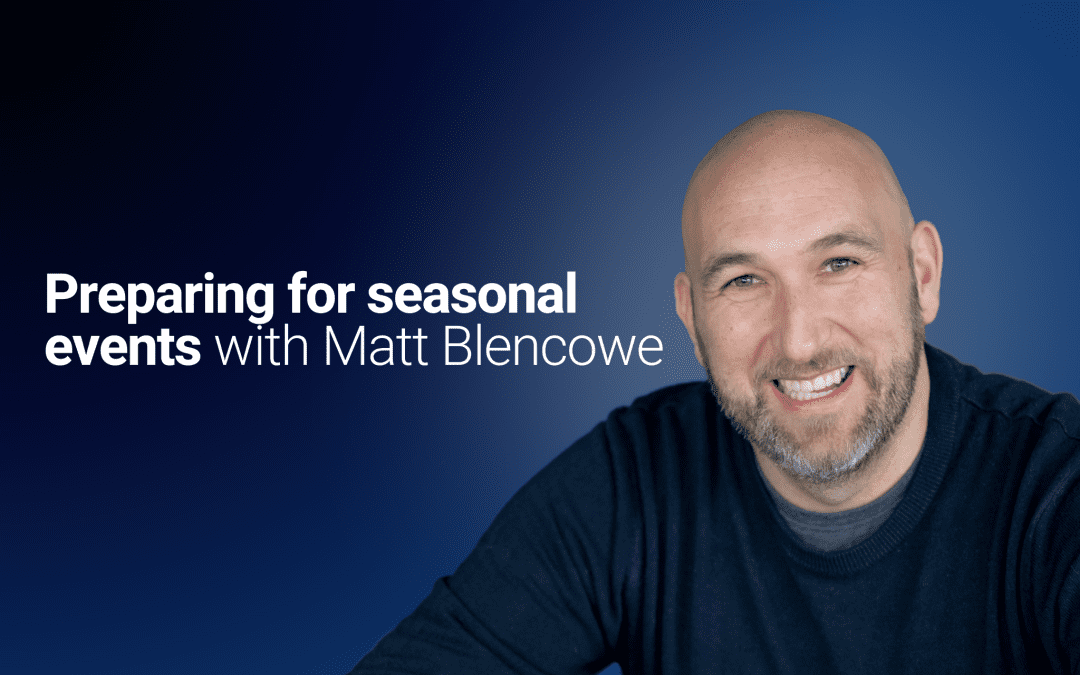It’s hard out there. Retail marketing is a hyper-saturated and super-competitive space – and if you’re not fighting for the top spot, you’re likely already on the bottom shelf.
For brands and retail businesses alike, your marketing efforts are key to nabbing potential customers and turning them into loyal fans.
But with even more influence on products at the shelf-side – such as rising living costs and pressure on multi-channel marketing and supply chains – it can seem like the customer journey is the least of your worries.
Ignore that inclination. As the name suggests, the retail industry needs good retail marketing like buns and burgers. Fish and water. Ant and Dec.
So how do you go about it?
In this guide – written by the boffins here at Tactical Solutions – we’ll unpick everything about these marketing methods. That includes giving you all the information you’ll need to get your target customers to bond with your product in both online and physical stores.
The article at a glance:
- What is retail marketing?
- A closer look at the different types of retail marketing
- The overall benefits
- Types of retail marketing strategies
- How Tactical Solutions can help your efforts
- And much more!
Time to get your marketing out of bed, Grandpa Joe. We’ve got the golden ticket.
What is retail marketing?
Lesson one. What does retail marketing actually mean?
Well, retail marketing is the act of creating a ‘buzz’ around a brand or product in order to boost sales, visibility, and profits.
Usually, well-done retailing means that a product forges a relationship with the target audience (bolstering customer loyalty) through the use of promotions and effective pricing structures.
As customers explore the retailing process, marketing increases its value. You can do this in a few ways, such as:
- cost reduction
- convenience
- loyalty programs
- quality packaging
This sets it apart from usual retailing, where goods are simply sold to buyers.
Types of retail marketing
Marketing takes many forms, captain. It’s a beastie that needs to be fully understood before it’s tamed (or at least carried out and placed in front of thousands of eyeballs up and down the country).
Retail marketing is generally known to fit into three distinct categories. These are based on the places where your customers will interact with your campaigns and strategies ‘in the wild’, whether that’s on the shelf of their local supermarket, on a billboard driving the kids to school, or on the world wide web.
Tweaking your activity to suit each one is an art in itself, as each environment has its own strengths and weaknesses.
Let’s dive in.
Store-based retail marketing
In-store marketing refers to any promotional activities that take place inside your store. It promotes products to customers and provides them a comfortable experience. In-store marketing, in other words, focuses on engaging customers as they go through the shopping journey.
Examples of in-store marketing include:
- In-store displays that feature certain products or price cuts
- Offer samples of new products
- Hosting events like live music or product demos
- Having a suggestion box or interactive board
- In-store promotions that encourage your customers to walk into your store
Non-store-based retail marketing
Traditional marketing refers to finding a target audience through offline channels like print marketing or billboard ads. While digital marketing has eclipsed traditional marketing for many industries, ol’ pen and paper still a good way to connect with local audiences.
Common channels include:
- Flyers and brochures
- Direct mail
- Newspaper ads
- Event marketing, like pop-ups
- Referral marketing
- Radio ads
Digital retail marketing
Digital marketing is the act of promoting your store or products through organic and paid efforts using online platforms. A well-rounded digital marketing strategy encompasses multiple channels, such as:
- SEO
- TikTok
- SMS
The channels you choose depend on where your audience hangs out, your budget, and your overall business goals.
Let’s talk about the retail marketing mix
It’s elementary, my dear reader.
Honestly. That’s why we’re relearning our ABCs. Or Ps and Cs.
Like most aspects of marketing, retail marketing is ‘held up’ by certain principles, known as the ‘marketing mix’ which is handily condensed into acronyms. Namely, four Ps and four Cs.
The four C’s cover: communication, cost, convenience, and customer. As for the 4 P’s, they stand for product, price, place, and promotion.
Although they might stand for similar principles, the two represent different ways to strategically drive foot traffic to your shelves – both online and in-store.
You see, 4Ps represent a retailer-driven marketing strategy while 4Cs represent a consumer-driven marketing strategy.
Shall we take a closer look?
Four Ps
Price
In retail, price plays an important role in sales performance and business stability. Retailers can boost customer loyalty and target customers by finding the right prices for their goods. After all, pricing that attracts customers may also increase a retailer’s sales and revenue – making it a no-brainer.
Product
Let’s be honest, in order to carry out effective marketing, it’s important to have a product that your target market wants to buy. If a product is attractive to buyers, retailers may be able to increase their sales. So in order to make your product look appealing, you might consider looking at how other retailers advertise their products, including product branding and packaging.
Place
It’s obvious, but there must be a place to buy a retailer’s products. Whether this place is online or offline, it’s imperative that your retail marketing makes it simple for clients to purchase your products. Why? Because if the sales process and customer journey is easy to navigate and super convenient, you’ll win them over much easier.
Promotion
In order to increase long-term sales, retailers are encouraged to spend money on promotions. The purpose of promotion is to raise consumer awareness of a product through good advertising, publicity, and other means. Using this strategy can be an effective way for retailers to sell their products.
Common promotional tactics include:
- Sales promotions
- Advertising
- Publicity
- Direct marketing
- Viral marketing
Got these down? Great. Let’s move on to the Four Cs.
Four Cs
Consumer
If retail marketing is a delicious burger (veggie or otherwise, depending on your preference) – then the consumer is the customer who decides to buy it.
A marketing strategy always puts the consumer at the heart of its consideration – after all, they are the ones that are spending their hard-earned money on your products. They are your ideal target and consumer, and they need to be the main star of any – and all – strategies.
Sure, you can’t make a product for everyone. But if you try to take their thoughts, lifestyles, and journey into account while developing your products – take their habits and behaviour profiles into account.
After all, their consumer base also includes a range of psychological reactions and wants for your brand – in addition to a demographic profile.
So, to be successful in retail marketing, you must know how to connect with – and entice – potential customers so they take your product from the shelf, scan it and take it home with them.
Cost
Let’s talk about moolah.
Cost is the amount you spend to make and market a product. In the same breath, it’s also how much money is required to pay for a new customer – making it one of the most crucial things to consider in the retail marketing mix.
Of course, the best situation for any brand is that a balance is made between the expense of actually making and selling a product – and how much it’s sold for.
However, that shouldn’t mean that you should skimp on your marketing efforts. That hard-earned cash can get you hard-earned customers, especially when you fork out for things such as distribution strategies, the price of sales, PR, and advertising.
Sometimes the good things in life aren’t free. But you knew that anyway.
Communication
Communication is a two-way street.
That goes between you and your customers – so it’s not enough to keep banging on about how great your products are. You have to understand what they are saying back.
What are their wants? What attracts them to your offering in particular? Heck, what are the things that are turning them off completely?
Don’t worry. Unlike first dates, you can enlist the help of consumer research, focus groups and surveys to help you get a full scope.
Marketing tactics such as SEO-optimised websites, email newsletters, social media campaigns, fliers, and newspaper ads are all examples of brand-to-customer communication.
Do it well, and you can build trusted relationships that can last a lifetime.
Convenience
Convenience is all about how easy and simple it is for members of the public to get their mitts on your stuff, no matter the hour or location.
When it comes to convenience, you should be ahead of your customers – since they know what they want. And as the old adage goes, “the customer is always right.”
If you position yourself as the market leader in a specific field, you need to make things convenient and easy for customers to access your products.
Think easy signage, clear planograms for shelf-side location, scannable labels and more, to help your customers compare prices, find what they are looking for or simply stop them from going anywhere else.
A closer look at retail marketing strategies
So you’ve got all the crucial ingredients. Now it’s time to put them together into the perfect recipe for your product: a retail marketing strategy.
In this section, we’ll touch on everything you need to know about putting one together (using the Four Cs and Ps will certainly help) – before discovering the sheer benefits it can give your brand.
Got your attention? Thought so.
What is a retail marketing strategy?
Consumers are encouraged to buy retail brands’ products through retail marketing. This type of marketing strategy outlines the exact tactics brands will use to encourage customers to buy more from them.
You can use many different routes in your retail marketing strategy to reach more sales. Much like fingerprints, a brand’s marketing strategy can be entirely unique, dispatched through in-store planning or online sales, for instance.
Whichever method you choose, it’s pretty much a given that an effective retail marketing strategy will combine several approaches in the current market.
Some food for thought: strategy examples
A retail marketing strategy is any activity you use to attract customers to your store. Retailers rely on many types of marketing strategies across different channels to meet their goals.
The following methods are popular:
- Organised retail displays
- Build your online presence/SEO efforts
- Boost advertising in-store and locally
- Stay connected with customers
- Work with influencers
- Invest in word-of-mouth marketing
- And many more.
Depending on your particular brand and store offering will, obviously, change the path of your marketing strategy. An online store will need a physical pop-up advertising budget like a fish needs a Peloton, so it’s important to stay savvy and funnel resources where they’re needed.
Go fish where your public lives. Then you might get a bite – rather than a nibble.
Why is retail marketing so crucial?
In a nutshell, retail marketing helps manufacturers get products to consumers.
Capiche? Capiche.
But if you’re still not sold, here are some of the cornerstone reasons why this form of marketing is important in business:
Build, boost and bolster customer loyalty
Loyalty. It ain’t just for dogs.
While daily sales are a businesses’ bread and butter, getting repeat traffic is the lifeblood of any solid brand. According to statistics, increasing your customer retention by 5%, you can increase your profits by up to 95% – which isn’t to be sniffed at.
Customers are more likely to stay loyal to retailers when they are provided with feedback requests, loyalty programs, and email or SMS marketing.
Money matters
We all know money makes the world go round.
Of course, the main goal of retail marketing is to boost your profits, which is why a solid strategy can introduce new customers and keep them there. To do this, you can wield SEO, partnerships, paid advertising and more to secure that holy grail*.
*Return On Investment.
Brawny branding
Consistency is key. A great retail marketing strategy can both boost your brands’ presence and make your products stand out from the shelf over time, with recognizable packaging, presentation and more.
Happy customers, happy brands.
Researchers and market experts combine their knowledge to increase customer satisfaction in retail, helping brands make strategies that go the extra mile.
That often means going into the fray and figuring out what frustrates their target market on a daily basis, while figuring out what they can do to make their product even better.
From delivery options, discounts and additional offers, you can tap into your target audience’s psyche and make their brains happy.
Happy people make the shops go round – and they are more likely to splash the cash with brands that tick their boxes over your competitors.
Data, data and more data
Often, retailers have a deep understanding of their customers’ wants and needs – which provides crucial insights for manufacturers or suppliers. This helps the in-house boffins improve product development and marketing by using super-fresh market data as a guide, and as you know, better products mean better profits and sales.
That’s catnip for retailers, suppliers and brands.
Helps businesses big and small
A strong retail strategy can assist brands big and small to get those products seen by the people who matter. It’s all about making your offering as attractive as possible, which any company can do – whether they have large-scale operations or are simply working with one or two lines of products.
A strategy can also pivot depending on scaleable budgets, so that the business can concentrate on other unique selling points like convenience and pricing, rather than spending money on huge promotions where it isn’t needed.
After all, making a splash doesn’t have to cost a bomb.
Turn to Tactical Solutions
Let’s be real, here.
No business in the retail sector can afford to operate without a bespoke strategy and approach.
Luckily for you, that’s where we come in.
Partnering with Tactical Solutions means that your retail strategy gets the attention and dedication it needs, so you can rest assured your business is in the best hands – and brains – around.
Why? Well, we’ve got the chops from years of experience working with some of the biggest brands and retailers on the market, so we know what it takes to supercharge your offering.




